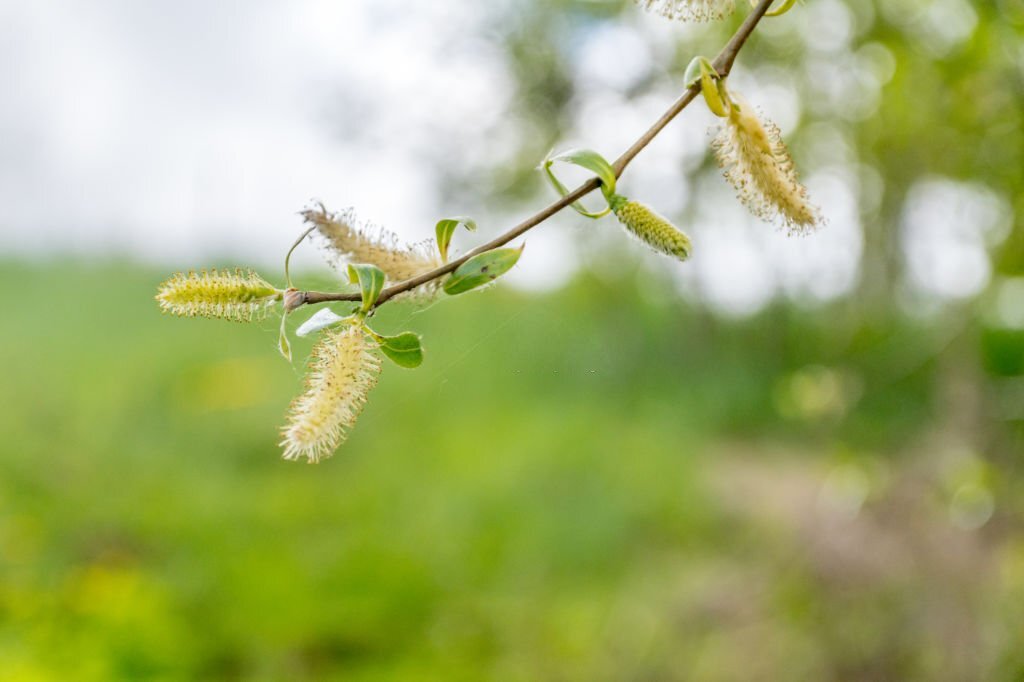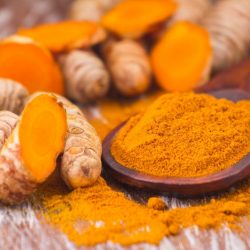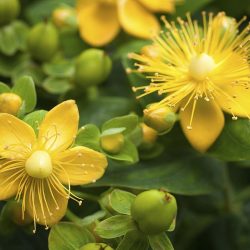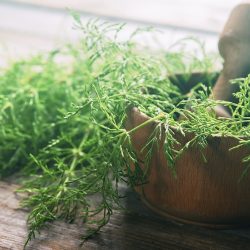As indicated by its Celtic root sa-lis (or salik ) which means ” near water “, the willow particularly likes temperate places throughout the northern hemisphere , along rivers and streams, on cool and humid grounds, even marshy, but above all it is a “green and beneficial tree of running waters” and riparian forests.
A bit of mythology
Mentioned in the Iliad , the willow also appears in the Odyssey : a word from the magician goddess Circe recalls the existence of a sacred wood dedicated to Persephone made up of black poplars and willows, which Pausanias will repeat identically a thousand years later. Willows have also been placed in the meadow which leads to the residence of Circe .
Beyond mythology, the first Greeks to mention the willow from a medical point of view were Hippocrates (who would advise its leaves against rheumatic and feverish ailments) and Theophrastus , even though the centaur Chiron is said to explain to Asclepius the therapeutic properties of willow leaves.
A little history
At the very beginning of our era, it was spotted by Dioscorides for its astringent, healing and analgesic properties. Using both seeds, bark and sap, Dioscorides uses willow for certain skin conditions (calluses, leeks), in cases of haemoptysis and auricular pain. Pliny , openly repeating Dioscorides , points out in his Natural History that “pounded leaves and taken as a drink moderate amorous excesses and repeated use extinguishes them completely. This anaphrodisiac property of the white willow, which some, until recently, took for a friendly joke, has been talked about for more than two millennia.
The reputation of the white willow is well established. Assyrians and Babylonians already saw in this tree a means of fighting against intermittent fevers. Together with the cypress , the willow dominated the pharmacopoeia of the time. At least this is explained by tablets bearing cuneiform characters.
What are the main pharmacological properties of white willow bark?
Anti-inflammatory properties:
Salicylic acid is present in willow in this form or from the oxidative transformation of salicylic alcohol (= saligenin ), itself from hydrolysis by the gut microbiota of native salicoside or slow degradation salicortin . _
An in vivo study has shown that oral administration of salicylic acid exerts an inhibitory action on cyclooxygenase , like aspirin (= acetylsalicylic acid ). This leads to a reduction in the concentration of thromboxanes B2, and to a dose-dependent decrease in the biosynthesis of prostaglandins type 2 (PGE2) in the serum.
This same study allowed the comparative pharmacological study of salicylic acid ( salicylate ) and aspirin, and showed that salicylate is rapidly metabolized, resulting in maximum concentrations in plasma and in inflammatory exudates exceeding 30 to 50 times the maximum concentrations of aspirin. Additionally, aspirin concentrations declined rapidly, whereas elevated salicylate concentrations persisted in plasma and exudate for up to 6 hours after a single aspirin administration. The salicylate concentrationfound in inflammatory exudates 6 hours after aspirin administration was sufficient to reduce PGE2 production by more than 50%.
Analgesic and antirheumatic properties:
In a 2000 randomized, double-blind study of 210 subjects with chronic low back pain , researchers found that after 4 weeks, 39% of patients given willow bark extract no longer felt pain. no pain, compared to 6% of subjects in the placebo group, which is statistically significant.
In 2001, a double-blind, placebo-controlled, randomized clinical trial, conducted over 2 weeks with 78 subjects with osteoarthritis of the knee or hip , showed a 14% decrease in pain in subjects treated with a willow bark extract and a 2% increase in those given a placebo.
According to a 2015 publication, although willow bark extracts are generally standardized in salicin , other ingredients, including other salicylates , as well as polyphenols and flavonoids, may also play important roles in therapeutic actions. . This work confirms that the adverse effects seem minimal compared to non-steroidal anti-inflammatory drugs, in particular aspirin.
Are there any precautions for use with White Willow?
Contraindications:
- Contraindicated in case of allergy to aspirin, acetylsalicylate derivatives (0.2% of the population), or other anti-inflammatories (for example, history of angioedema, spasms or chronic urticaria) , as well as in case of asthma triggered by aspirin, Widal syndrome.
- In the absence of additional data, the existence in the medical history of Reye’s syndrome remains a contraindication.
- However, there is no data indicating that willow bark poses the risk of causing Reye’s syndrome in children, although this contraindication holds for acetylsalicylic acid, due to the significantly different metabolism of willow compounds. White.
- As a precautionary principle, the EMA does not recommend the use of willow during the 1st and 2nd trimester of pregnancy, as well as during breastfeeding.
Side effects :
- Rare gastrointestinal disorders, attributable to the presence of tannins.
- Possibility of nausea, diarrhea and allergic reactions (rash, pruritus, urticaria, asthma, exanthema).
Precautions for use:
- Salicosides and salicortin , brought by the intake of willow, are metabolized in the intestine into saligenin and after absorption, transformed into salicylic acid (and not into acetylsalicylic acid with liver toxicity). As a result, gastric tolerance is much better and willow does not have the undesirable effects of aspirin.
- In the context of self-medication, the EMA recommends limiting the duration of treatment to 4 weeks for joint pain, 3 days in febrile states related to colds, and 1 day in headaches. Beyond that, she advises to take a medical opinion.
Drugs interactions :
- Caution, do not use in patients taking anticoagulants (monitor INR biology) or antiplatelet agents.
- White willow may also interact with aspirin and nonsteroidal anti-inflammatory drugs.
- Interactions with warfarin.
How to take Willow and at what dosage?
Dry form:
- As a food supplement in the form of capsules, at the rate of one capsule per day during the meal with a glass of water.
Liquid form:
- Fluid extract of fresh plant standardized for officinal preparation : 5 to 10 ml per day in a glass of water.
- Decoction : 2 to 3 g of bark, boil 10 minutes, 1 cup 2 to 4 times a day.
Medical bibliographic sources and clinical trials :
-
Chrubasik S. et al., Treatment of low back pain exacerbations with willow bark extract : a randomised double-blind study, Am. J. Med., 2000
-
Higgs G.A. et al., Pharmacokinetics of aspirin and salicylate in relation to inhibition of arachidonate cyclooxygenase and antiinflammatory activity, Proc. Natl, Acad. Sci., 1987
-
Schmid B. et al., Efficacy and tolerability of a standardized willow bark extract in patients with osteoarthritis : randomized placebo-controlled, double blind car clinical trial, Phytother. Res., 2001
-
Shara M. et al., Efficacy and Safety of White Willow Bark (Salix alba) Extracts, Phytother Res. 2015
-
Sarwar Beg, Suryakanta Swain, Hameed Hasan, M Abul Barkat, Md Sarfaraz Hussain. Systematic review car of herbals as potential anti-inflammatory agents: Recent advances, current clinical status and future perspectives. Pharmacogn Rev. 2011
-
Mehdi Shakibaei, David Allaway, Simone Nebrich, Ali Mobasheri. Botanical Extracts from Rosehip (Rosa canina ), Willow Bark (Salix alba), and Nettle Leaf (Urtica dioica ) Suppress IL-1β-Induced NF-κB Activation in Canine Articular Chondrocytes. Evidence-Based Complementary and Alternative Medicine Volume 2012
-
Drummond EM, Harbourne N, Marete E, Martyn D, Jacquier J, O’Riordan D, Gibney ER. Inhibition of proinflammatory biomarkers in THP1 macrophages by polyphenols derived from chamomile, meadowsweet and willow bark. Phytother Car Res. 2013
-
Sharma S, Sahu D, Das HR, Sharma D. Amelioration of collagen-induced arthritis by Salix nigra bark extract via suppression of pro-inflammatory cytokines and oxidative stress. Food Chem Toxicol. 2011
-
Schmid B, Lüdtke R, Selbmann HK, Kötter I, Tschirdewahn B, Schaffner W, Heide L. Efficacy and tolerability of a standardized willow bark extract car in patients with osteoarthritis: randomized placebo-controlled, double blind clinical trial. Phytother Res. 2001
-
Soeken KL. Selected CAM therapies for arthritis-related pain: the evidence from systematic reviews. Clin J Pain. 2004
-
Alessandro Bartolini, Lorenzo Di Cesare Mannelli, Car la Ghelardini. Analgesic and Antineuropathic Drugs Acting Through Central Cholinergic Mechanisms. Recent Pat CNS Drug Discov. 2011





